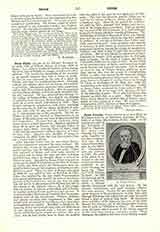

Peter Fourier, Saint, known as LE BON PERE DE MATTAINCOURT, b. at Mirecourt, Lorraine, November 30, 1565; d. at Gray, Haute-Saone, December 9, 1640. At fifteen he was sent to the University of Pont—a—Mousson. His piety and learning led many noble families to ask him to educate their sons. He became a Canon Regular in the Abbey of Chaumousey and was ordained in 1589. By order of his abbot he returned to the university and became proficient in patristic theology; he knew the “Sum-ma” of St. Thomas by heart. In 1597 he was made parish priest of Mattaincourt, a corrupt district threatened with the new heresy. By his prayers, instructions, and good example, religion was soon restored. Fourier did not neglect the temporal interests of his parishioners; to help those who through ill-fortune had fallen into poverty, he established a kind of mutual help bank. He instituted three sodalities, of St. Sebastian for men, of the Holy Rosary for women, and of the Immaculate Conception for girls, or “Children of Mary“. He composed some dialogues which treated of the virtues opposed to the vices most common among his people. These dialogues the children delivered every Sunday in public. To perpetuate his work, Peter founded in 1598 an order of women, the Congregation of Notre-Dame, who teach poor girls gratuitously. The institute spread and with some modifications was introduced into America by the Ven. Marguerite Bourgeoys (d. 1700).
In 1621, by order of the Bishop of Toul, Fourier undertook the reform of the canons regular in Lorraine who in 1629 formed the Congregation of Our Savior. Of this congregation he was made superior general in 1632. He wished his brother canons to do for boys what his nuns were doing for girls. In 1625 Peter was entrusted with the conversion of the Principality of Salm, near Nancy, which had gone over to Calvinism. In six months all the Protestants, whom he called “poor strangers”, had returned to the Faith. On account of his attachment to the House of Lorraine he was driven into exile at Gray, where he died. In 1730 Benedict XIII published the Decree of his Beatification, and Leo XIII canonized him in 1897.
A. ALLARIA

